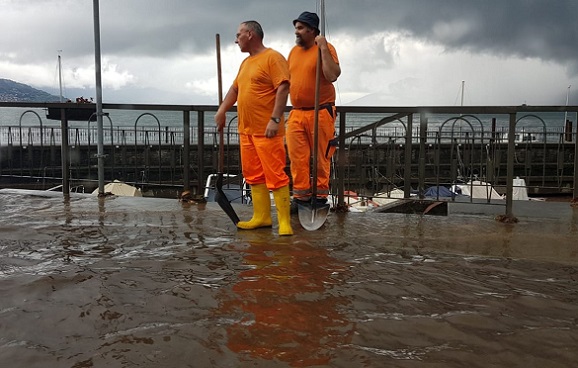Major improvements in dealing with natural hazards have been achieved in recent years. This is the finding of the progress report to the Federal Council on the implementation of the integrated risk management system for natural hazards. The key achievements of the past four years include the surface run-off risk map, which closes an important gap in the underlying data. When it comes to disaster response and regeneration, the federal government not only supports the cantons and communes financially, but now also provides a guide to emergency response planning for natural hazards such as floods.

Umgang mit Naturgefahren in der Schweiz (PDF, 2 MB, 18.12.2020)(in German and French)
Umgang mit Naturgefahren in der Schweiz

This publication does not exist in English. It is available in other languages.
In a broad-based situation analysis on dealing with natural hazards, over 60 measures to improve protection against natural hazards were proposed, and passed by the Federal Council in 2016.
Current Situation
In December 2020, the FOEN submitted a first progress report to the Federal Council on the implementation of these measures. The result is positive: over the past four years, a wide range of stakeholders have launched numerous projects, some of which have already been successfully completed. The current implementation status is 50 per cent. The report primarily describes measures that are at an advanced stage of implementation. The measures fall within five fields of action.
The basic hazard and risk data field has seen the highest number of projects started over the past three years. Some of the most important measures set to be implemented in this field include expanding and periodically updating the basic hazard data and drawing up cantonal and national risk overviews. Projects that have already been successfully completed include the nationwide Swiss surface run-off risk map and the methodology to be followed by the cantons when drawing up risk overviews.
An important development in the field of prevention is that planning now takes account of risk levels as well as hazards. This applies both to action planning and to land-use planning. In some cases, changes to the law will be necessary. A new emergency response planning guide is now available.
The Swiss Society of Engineers and Architects (SIA) and the insurance companies are currently carrying out numerous activities relating to building practices for natural hazard mitigation. SIA standard 261/1 has been revised to take account of natural hazards and the new version has been published.
In the response and regeneration field, improvements are needed in relation to flood management and the coordination of federal subsidies made available in the event of a disaster. In the area of flood management, the main focus is on risk-based lake regulation and on improving hydrological forecasts.
In the field of risk communication, education and research the aim is to promote knowledge of a risk-based approach to dealing with natural hazards and to increase risk awareness. The target group consists of everyone who is affected or involved. Information and training on prevention and emergency response for natural hazards are being improved all the time. One measure designed to close the research gaps in the area of weather and climate risks has already been implemented by establishing a professorship in this field at ETH Zurich.
In the field of overarching plans and collaboration, measures are being implemented to ensure effective, efficient and coordinated implementation of the integrated risk management approach. Specifically, these involve overarching cantonal and national plans that identify a need for action based on basic hazard data and risk overviews. Minimum standards are currently being developed for comprehensive planning at cantonal level.
Outlook
Changes to legislation are needed for the implementation of some measures. The Hydraulic Engineering Act will need to be partially revised and the Forest Act and Waters Protection Act will require adaptation. In terms of content, the aim is to enshrine integrated risk management in law, to remove disincentives through equal support for the various types of measures and to establish the cantons’ obligation to draw up risk overviews and comprehensive plans. The consultation took place in 2021.
The next progress report on the implementation of measures for integrated risk management of natural hazards is planned for 2025.
Last modification 11.08.2022





